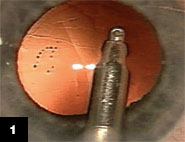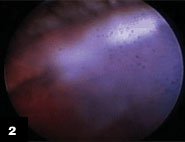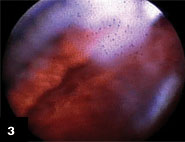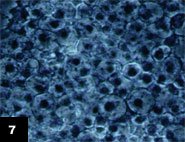Good cortical cleanup essential for PCO prevention
An endoscopic study shows that residual cortex, cortical fibers and cells in the capsular fornix can be missed during irrigation and aspiration.
Posterior capsular opacification is the most common complication following pediatric and adult cataract and lens implant surgery. Capsular bag opacification occurs due to proliferation and migration of the lens epithelial cells present on the anterior and equatorial areas of the capsular bag and within the residual cortex and cortical fibers. It can be subclassified as anterior, equatorial and posterior capsular opacification.
It is possible to obtain a 360° view of the peripheral capsular bag (capsular fornices) in postmortem eyes using an oblique or side view by creating a uveoscleral window or using the posterior video technique of Miyake-Apple. However, intraoperatively in living eyes, it is not possible to visualize the peripheral capsular bag (capsular fornices), which are hidden by the iris root. Therefore, it is difficult to remove the residual cortex, cortical fibers and cells within the capsular fornices under direct visualization with a surgical microscope.
The aim of this two-part study was to highlight surgical strategies for complete cortical cleanup and lens epithelial cell (LEC) removal.
In the first part, we propose a novel technique to obtain intraoperative visualization of capsular fornices for the presence or absence of residual cortex and cortical fibers during cataract surgery using a fiber-optic endoscope. In the second part, we present an experimental study evaluating the effect of distilled water for irrigation on the LECs present on anterior capsulectomy (capsulorrhexis) specimens.
Fiber-optic visualization
In the first part of the study, a fiber-optic endoscopy technique was used to visualize the capsular fornices. Six cases of age-related cataract (without any ocular or systemic pathology) underwent routine phacoemulsification. Standard surgical technique (capsulorrhexis, hydrodissection, hydrodelineation, rotation, nuclear emulsification, irrigation and aspiration, and lens implantation) was used in all cases. Immediately after I&A and prior to IOL implantation, a fiber-optic endoscope was inserted in the anterior chamber and capsular bag to examine the capsular fornices for the presence or absence of residual cortex, fibers and LECs.
There were no intraoperative complications in any of the cases. The capsular bag appeared cleaned when viewed through a surgical microscope (Figure 1). However, endoscope-assisted visualization of the capsular fornices suggested varying degrees of residual cortex, fibers and LECs within the capsular fornices in all cases (Figures 2 and 3).
It was possible to remove the residual cortex and cortical fibers using bimanual or coaxial irrigation and aspiration with or without CapVac setting. The anterior capsule and capsular bag had a slight blue tinge probably due to the presence of LECs (Figure 4).
The endoscope was then reinserted to confirm the presence or absence of the residual cortex. The absence of residual cortical material and cortical strands from the capsular bag is pictured in Figure 5.
 |  |  |
| Through the surgical microscope, the capsular bag appears to be clear. | Endoscopy of the capsular fornix shows a varying degree of residual cortex, fibers and lens epithelial cells. | |
Distilled water and LECs
The second part of the study was an experimental study to evaluate the effect of distilled water irrigation (DWI) on the LECs present on anterior capsulectomy (capsulorrhexis) specimens.
Anterior capsulectomy specimens of approximately 4.5 mm to 5 mm were obtained from six cases during routine cataract surgery. After completion of the capsulorrhexis, excised anterior capsules were placed on the anterior surface of the cornea and gently rinsed with balanced salt solution to remove the residual viscoelastic, if any. The capsules were then transferred to a plastic vial containing minimal essential (M-199) media. The plastic vials containing the specimens were then transferred from the operating room to the laboratory. The capsulectomy specimens were placed within a culture plate containing minimal essential media (M-199). The anterior capsulectomy specimen was fixated in the culture plate using metallic pins to avoid its displacement during DWI.
The culture plate was placed on the phase contrast microscope. An area was selected containing viable LECs. A digital timer was used to note the time of treatment of LECs with DWI. Approximately 30 cc of DWI was used for irrigation of the LECs present on the fixated anterior capsule. During the initial experiments, distilled water was used for a maximum of 2 minutes. Staining with 0.001% trypan blue solution was used to confirm nonviability of the LECs.
The LECs were completely lysed in five cases after DWI exposure of 120 seconds. Lysis of LECs was incomplete in one specimen, where a few cortical fibers were present, thus not allowing DWI to lyse the cells. The earliest microscopic evidence of cell lysis was seen after 30 seconds of exposure to DWI. At this stage, the cell nuclei were stained with trypan blue, which was suggestive of nonviable cells (Figure 6). The nuclei were swollen and stained densely with trypan blue as time progressed to 120 seconds (Figure 7).
|
|
| |
|
|
| |
Discussion
Owing to the localization deep in the fornix of the capsular bag, the residual cortex and germinative LECs may escape complete removal during I&A. Thorough cortical fiber cleanup and successful removal of potent pre-equatorial germinative cells in significant quantities remain the basis for reducing capsular bag opacification.
Endoscopic visualization of the capsular fornices suggested the presence of variable amounts of residual cortex, fibers and LECs within the capsular fornices during routine cataract surgery, even in the hands of an experienced surgeon. Experimental studies in rabbit and human eyes suggested that the retained residual cortex in the capsular bag can harbor mitotically active LECs.
The lens cortex and cortical fibers may prevent the osmotic effect of DWI on the lens epithelial cells as observed in one capsulectomy specimen in our in vitro study. Presence of residual cortex and fibers may be attributed to incomplete lysis of LECs in a clinical setting when using a sealed capsule irrigation technique, as is performed with Milvella’s PerfectCapsule device. Studies have also suggested that the residual, regenerating cortex may dissolve an existing capsular bend and allow LECs to migrate into the space between the IOL optic and posterior capsule. This may lead to visually significant posterior capsular opacification, even after implantation of a square-edged lens.
Selective delivery of DWI into the human capsular bag is now possible using sealed capsule irrigation, or SCI, with the PerfectCapsule device, which allows isolation of LECs and positive pressure inflation of the capsular bag intraoperatively. We have demonstrated lysis of the LECs using DWI in a laboratory setting. In spite of complete lysis of the LECs in an in vitro setting, there can be some variation when DWI is used in a clinical setting. Using SCI may influence the efficacy of DWI. Variations may appear in the presence of residual cortex within the capsular fornices, presence of viscoelastic in the capsular bag and role of the inflammatory mediators secondary to disruption of the blood-aqueous barrier during the cataract surgery.
In summary, endoscopic visualization of the capsular bag suggests presence of residual cortex and cortical fibers within the capsular fornices despite an apparently clean appearance of the capsular bag under the operating microscope. In an in vitro study, we have successfully demonstrated complete lysis of residual LECs present on the anterior lens capsule using DWI. Capsular bag opacification is a multifactorial process. A good cortical cleanup and removal of LECs is critical for maintaining capsular bag transparency, which is important for a long-term successful visual outcome with injectable, accommodative, refractive and new-technology IOL implants.
For Your Information:
- Suresh K. Pandey, MD, can be reached at the Intraocular Implant Unit, Sydney Eye Hospital, GPO Box 1614, 8 Macquarie Street, Sydney, NSW, Australia; +61-2-9382 7433; fax: +61-2-9382 7401; e-mail: suresh.pandey@gmail.com. Dr. Pandey has no financial interest in the products mentioned in this article, nor is he an employee or paid consultant for any company mentioned.
- E. John Milverton, MBBS, DO, FRANZCO, FRCOphth, and Anthony J. Maloof, MBBS, MbiomedE, FRANZCO, FRACS, can be reached at the Intraocular Implant Unit, Sydney Eye Hospital, Macquarie Street, Sydney 2000, NSW, Australia. Drs. Milverton and Maloof have a direct financial interest in the PerfectCapsule device. They are not employees or consultants to any company mentioned.
References:
- Apple DJ, Lim ES, et al. Preparation and study of human eyes obtained postmortem with the Miyake posterior photographic technique. Ophthalmology. 1990;97:810-816.
- Assia EI, Apple DJ. Side-view analysis of the lens. I. The crystalline lens and the evacuated bag. Arch Ophthalmol. 1992;110(1):89-93.
- Dewey SH, Werner L, et al. Preventing PCO: The Bend and Beyond. Video presented at: American Society of Cataract and Refractive Surgery Symposium on Cataract, IOL, and Refractive Surgery; May 2004; San Diego, Calif.
- Maloof AJ, Neilson G, et al. Selective and specific targeting of lens epithelial cells during cataract surgery using sealed-capsule irrigation. J Cataract Refract Surg. 2003;29:1566-1568.
- Maloof A, Pandey SK, et al. Selective death of lens epithelial cells using demineralized water and triton X-100 with PerfectCapsule Sealed Capsule Irrigation: A histological study in rabbit eyes. Arch Ophthalmol. 2005 (in press).
- Miyake K, Miyake C. Intraoperative posterior chamber lens haptic fixation in the human cadaver eye. Ophthalmic Surg. 1985;16:230-236.
- Pandey SK, Apple DJ, et al. Posterior capsule opacification: a review of the aetiopathogenesis, experimental and clinical studies and factors for prevention. Indian J Ophthalmol. 2004;52(2):99-112.
- Pandey SK, Apple DJ, et al. Surgical & implant related factors to prevent posterior capsule opacification. In: Garg A, Pandey SK, Chang DF, et al., eds. Advances in Ophthalmology. New Delhi, India, Jaypee, 2005; 190-199.
- Pandey SK, Wilson ME, et al. Pediatric cataract surgery and intraocular lens implantation: current techniques, complications and management. Int Ophthalmol Clin. 2001;41:175-196.
- Peng Q, Visessook N, et al. Surgical prevention of posterior capsule opacification. Part 3: Intraocular lens optic barrier effect as a second line of defense. J Cataract Refract Surg. 2000;26(2):198-213.
- Peng Q, Apple DJ, et al. Surgical prevention of posterior capsule opacification. Part 2: Enhancement of cortical cleanup by focusing on hydrodissection. J Cataract Refract Surg. 2000;26(2):188-197.
- Werner L, Apple DJ, et al. Postoperative proliferation of anterior and equatorial lens epithelial cells: A comparison between various foldable IOL designs. In: Buratto L, Osher R, Masket S, eds. Cataract surgery in complicated cases. Thorofare, NJ, Slack Inc., 2000; 399-417.




